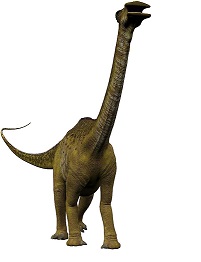
Nigersaurus is a fascinating Dinosaur known for its unique physical characteristics and its importance in our understanding of the diversity of sauropod dinosaurs. Discovered in the Republic of Niger, Africa, Nigersaurus belongs to the sauropod group, which includes some of the largest terrestrial animals to have ever lived on Earth. This dinosaur provides valuable insights into the evolution and adaptations of long-necked, herbivorous dinosaurs that dominated the Mesozoic era.
Nigersaurus was first described in 1999 by Sereno and colleagues. The genus name "Nigersaurus" is derived from the country Niger, where the fossils were found, and the species name "taqueti" honors French paleontologist Philippe Taquet, who contributed significantly to African paleontology.
| Name: | Nigersaurus dinosaurs |
| Size: | Around 9 meters(length),around 4,000 to 5,500 kilograms(weight) |
| Main Facts: | Nigersaurus had a remarkably long neck with over a dozen cervical vertebrae and hundreds of small, pencil-shaped teeth. |
Nigersaurus lived during the Early Cretaceous period, approximately 119 to 113 million years ago. At this time, Africa was part of the supercontinent Gondwana, and the region that is now Niger was a lush, river-dominated environment.

Nigersaurus possessed several distinct physical characteristics that set it apart from other sauropod dinosaurs. Its most striking feature was its exceptionally long neck, consisting of over a dozen elongated cervical vertebrae. This unique adaptation allowed Nigersaurus to browse vegetation high up in trees, reaching plants that other dinosaurs could not access.
The dinosaur's skull was also highly specialized, characterized by a broad, flat shape. Its jaws were equipped with hundreds of small, pencil-shaped teeth that were continuously replaced throughout its life, forming a dental battery. This dental arrangement was unlike other sauropods, allowing Nigersaurus to crop vegetation efficiently.
Nigersaurus was a relatively small sauropod, measuring about 9 meters (30 feet) in length. Despite its elongated neck, it had a light body compared to other sauropods, estimated to weigh around 4,000 to 5,500 kilograms (4 to 5.5 metric tons).
These physical characteristics, including the long neck, unique skull shape, and specialized dental adaptations, made Nigersaurus an extraordinary dinosaur, revealing fascinating insights into the adaptations and diversity of sauropods during the Early Cretaceous period.
Nigersaurus is a unique sauropod dinosaur from the Early Cretaceous period, discovered in Niger, Africa. It was relatively small, about 9 meters in length, with an incredibly elongated neck and a broad, flat skull. Its most distinct feature was its dental adaptation, possessing hundreds of small, pencil-shaped teeth that were continuously replaced throughout its life, allowing it to efficiently crop vegetation.
Nigersaurus was a herbivorous dinosaur, grazing on ferns, cycads, and other low-lying vegetation. Its feeding behavior involved horizontally sweeping its broad muzzle across the ground, likened to a modern-day lawnmower. This dinosaur provides valuable insights into the diverse adaptations of sauropod dinosaurs during the Early Cretaceous.
Nigersaurus was relatively small for a sauropod, measuring about 9 meters (30 feet) in length. In comparison, other sauropods like Argentinosaurus and Diplodocus were much larger, reaching lengths of up to 100 feet or more.
Nigersaurus had an exceptionally long neck, with over a dozen cervical vertebrae. This allowed it to reach vegetation high up in trees. In contrast, some other sauropods had long necks too, but none were as elongated as Nigersaurus.
The most distinctive feature of Nigersaurus was its broad, flat skull, shaped like a wide muzzle. This was unique among sauropods, which typically had more elongated skulls.
Nigersaurus had specialized dental adaptations with hundreds of small, pencil-shaped teeth that were continuously replaced. This dental arrangement was unlike other sauropods, which had larger, peg-like teeth or more complex dentition.
Due to its unique dental adaptations and long neck, Nigersaurus likely had a different feeding behavior compared to other sauropods. It used its broad muzzle to sweep across the ground horizontally, cropping vegetation efficiently.
Nigersaurus lived in the Early Cretaceous period in riverine floodplains, whereas some other sauropods were found in different habitats, such as forests or coastal areas.
Like other sauropods, Nigersaurus was quadrupedal, walking on all four legs. Its elongated neck was held horizontally for feeding, while some other sauropods had more upright neck postures.
Nigersaurus, like many other sauropods, likely lived in herds for protection and efficient foraging. The behavior of sauropods in herds might have varied depending on the species and environmental conditions.